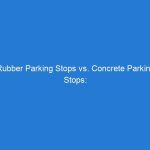Importance of speed bumps and humps
Speed bumps and humps are essential traffic calming measures that play a crucial role in ensuring road safety. They are designed to slow down vehicles, especially in areas with high pedestrian traffic, schools, hospitals, and residential areas. Speed bumps and humps help to reduce the risk of accidents, prevent reckless driving, and encourage drivers to adhere to speed limits. They also help to reduce noise pollution and improve the quality of life for residents living near busy roads. Therefore, the importance of speed bumps and humps cannot be overstated, and innovative designs are continually being developed to enhance their effectiveness.
Traditional designs and their limitations
Traditional speed bumps and humps have been used for decades to slow down traffic in residential areas, school zones, and parking lots. However, these designs have several limitations. Firstly, they can cause discomfort and even damage to vehicles if drivers do not slow down enough. Secondly, emergency vehicles such as ambulances and fire trucks may have difficulty navigating over them, potentially delaying response times. Lastly, traditional speed bumps and humps can be visually unappealing and may not fit in with the aesthetic of certain neighborhoods. As a result, there has been a push for more innovative designs that address these limitations while still effectively slowing down traffic.
Innovative Designs for Speed Bumps
Flat-top speed bumps
Flat-top speed bumps are a newer design that has gained popularity in recent years. Unlike traditional speed bumps, which have a rounded shape, flat-top speed bumps have a flat surface with a gradual incline and decline on either side. This design allows for a smoother ride for vehicles, reducing the risk of damage to cars and making them more comfortable for passengers. Additionally, flat-top speed bumps are often painted with bright colors or reflective materials to increase visibility and alert drivers to slow down. These features make flat-top speed bumps a safer and more effective option for controlling speed in areas where traditional speed bumps may not be suitable.
Rolling speed bumps
Rolling speed bumps are a new and innovative design that aims to reduce the discomfort and noise caused by traditional speed bumps. These speed bumps are made of a series of small rollers that are placed on the road surface. When a vehicle passes over them, the rollers rotate, creating a gentle and smooth ride. Rolling speed bumps are designed to slow down traffic without causing damage to vehicles or discomfort to drivers and passengers. They are also more environmentally friendly than traditional speed bumps, as they do not require any additional materials or energy to produce. Rolling speed bumps are becoming increasingly popular in urban areas, where traffic calming measures are needed to improve safety and reduce congestion.
Sinusoidal speed bumps
Sinusoidal speed bumps are a relatively new type of speed bump that is gaining popularity due to its unique design. Unlike traditional speed bumps, sinusoidal speed bumps are designed with a series of rounded bumps that are spaced out evenly. This design allows for a smoother ride over the speed bump, reducing the impact on vehicles and passengers. Additionally, the sinusoidal design allows for a reduction in speed without the need for a complete stop, making it a more efficient option for traffic calming. These speed bumps are also designed to be more visually appealing, with a sleek and modern look that blends in with the surrounding environment. Overall, sinusoidal speed bumps offer a more comfortable and effective solution for slowing down traffic in residential areas and parking lots.
Speed cushions
Speed cushions are a type of traffic calming measure that are designed to slow down vehicles without causing discomfort to emergency vehicles or buses. These cushions are typically made of rubber or plastic and are placed in a staggered pattern across the road. The cushions are designed to be wide enough to force drivers to slow down, but narrow enough to allow emergency vehicles and buses to straddle them without slowing down. Speed cushions have been shown to be effective in reducing speeds and improving safety on residential streets. However, some drivers may find them to be a nuisance and may try to avoid them by driving on the wrong side of the road.
Innovative Designs for Speed Humps
Split speed humps
Split speed humps are a variation of the traditional speed hump design that is gaining popularity in many cities. These humps are split into two sections, with a gap in the middle that allows vehicles with a longer wheelbase, such as buses and emergency vehicles, to pass over them without having to slow down. This design helps to reduce traffic congestion and delays, while still maintaining the safety benefits of traditional speed humps. Split speed humps are also more visually appealing than traditional speed humps, as they can be painted with different colors and patterns to blend in with the surrounding environment.
Inverted speed humps
Inverted speed humps are a relatively new design that has gained popularity in recent years. Unlike traditional speed humps that are raised, inverted speed humps are recessed into the road surface. This design allows for smoother and faster travel for emergency vehicles, buses, and other vehicles that require a smoother ride. Inverted speed humps also reduce noise pollution and are less visually obtrusive than traditional speed humps. Additionally, they are less likely to damage vehicles that may bottom out on traditional speed humps. Overall, inverted speed humps are a promising innovation in traffic calming measures.
Variable height speed humps
Variable height speed humps are a newer innovation in traffic calming measures. These speed humps are designed to adjust their height based on the speed of the approaching vehicle. When a vehicle is traveling at a higher speed, the hump will rise to a greater height, causing the driver to slow down. However, if a vehicle is traveling at a slower speed, the hump will remain at a lower height, allowing for a smoother ride. This technology is particularly useful in areas where speed limits vary or where emergency vehicles need to travel at higher speeds. Variable height speed humps are also more environmentally friendly, as they reduce the amount of noise pollution caused by traditional speed humps.
Speed tables
Speed tables are a type of traffic calming measure that are similar to speed humps, but with a longer and flatter surface. They are typically used in areas where traffic needs to slow down, such as school zones or residential areas. Speed tables are designed to be more comfortable for drivers to pass over at a slower speed, as they have a gentler slope and a longer flat section. This makes them a popular choice for areas where emergency vehicles need to maintain a higher speed, as they can pass over the speed table without having to slow down as much as they would for a speed hump. Additionally, speed tables can be designed with landscaping or other aesthetic features to make them more visually appealing and blend in with the surrounding environment.
Benefits of Innovative Designs
Improved traffic flow
Improved traffic flow is a major concern for many cities and towns. Traditional speed bumps and humps can slow down traffic and cause congestion, especially during peak hours. However, innovative designs such as the sinusoidal speed hump and the speed cushion have been developed to address this issue. The sinusoidal speed hump is designed to allow vehicles to maintain a higher speed while still reducing speed overall. The speed cushion is a raised platform with gaps that allow emergency vehicles to pass through without slowing down. These designs not only improve traffic flow but also enhance safety on the roads.
Reduced noise pollution
Reduced noise pollution is a major concern for many communities, especially those located near busy roads or highways. Traditional speed bumps and humps can create loud and jarring noises as vehicles pass over them, which can be disruptive to nearby residents. However, innovative designs for speed bumps and humps have been developed to address this issue. For example, some speed bumps are designed with a series of smaller bumps that are spaced out, which can reduce the noise created by vehicles passing over them. Other designs incorporate materials that absorb sound, such as rubber or asphalt, to further reduce noise pollution. These innovative designs not only improve safety on the roads but also enhance the quality of life for nearby residents.
Enhanced safety for pedestrians and cyclists
Speed bumps and humps have been designed to enhance the safety of pedestrians and cyclists. These innovative designs are aimed at reducing the speed of vehicles and making drivers more aware of their surroundings. Some speed bumps and humps are designed with reflective materials, making them more visible at night. Others are designed to be wider and longer, allowing for a smoother ride for cyclists. Additionally, some speed bumps and humps are designed to be more gradual, reducing the impact on vehicles and making them less likely to cause damage. These enhanced safety features are crucial in areas with high foot and bike traffic, ensuring that everyone can travel safely.
Less wear and tear on vehicles
One of the major concerns with traditional speed bumps and humps is the wear and tear they can cause on vehicles. However, innovative designs have been developed to address this issue. For example, some speed bumps are now made with a more gradual incline and decline, which reduces the impact on vehicles and their suspension systems. Additionally, some speed humps are designed with a wider base and a gentler slope, which spreads out the weight of the vehicle and reduces the jarring effect. These new designs not only improve the driving experience for motorists, but also help to prolong the lifespan of their vehicles.
Conclusion
Summary of innovative designs
In summary, there are several innovative designs for speed bumps and humps that have been developed in recent years. These include modular speed bumps that can be easily installed and removed, rubber speed humps that are more durable and effective than traditional asphalt humps, and even solar-powered speed bumps that light up at night to increase visibility. Additionally, some designs incorporate features such as reflective markings or textured surfaces to further enhance their effectiveness. These innovative designs offer a range of options for traffic calming measures that can be tailored to specific needs and locations.
Future possibilities for speed bumps and humps
Future possibilities for speed bumps and humps are exciting and promising. One potential development is the use of smart technology to create speed bumps that can adjust their height and angle based on the speed of the approaching vehicle. This would allow for a smoother ride for drivers who are traveling at or below the speed limit, while still effectively slowing down those who are speeding. Additionally, there is potential for the integration of renewable energy sources into speed bumps and humps, such as solar panels or kinetic energy harvesting systems. This would not only make them more environmentally friendly, but also potentially generate energy to power nearby streetlights or other infrastructure. As technology continues to advance, the possibilities for innovative and effective speed bump and hump designs are endless.
Next Steps: As we continue to explore innovative designs for speed bumps and humps, it’s important to consider the safety and efficiency of these traffic calming measures. At Unimat Traffic, we offer a range of high-quality speed bumps and humps that are designed to meet the needs of any traffic management project. Whether you’re looking for a durable and long-lasting solution for a busy roadway or a more flexible option for a residential area, our products are sure to meet your needs. Visit our website at https://unimat-traffic.com/products/speedbumps/ to learn more about our products and how they can help you create a safer and more efficient traffic environment. Don’t wait – take the next step towards safer roads today!










